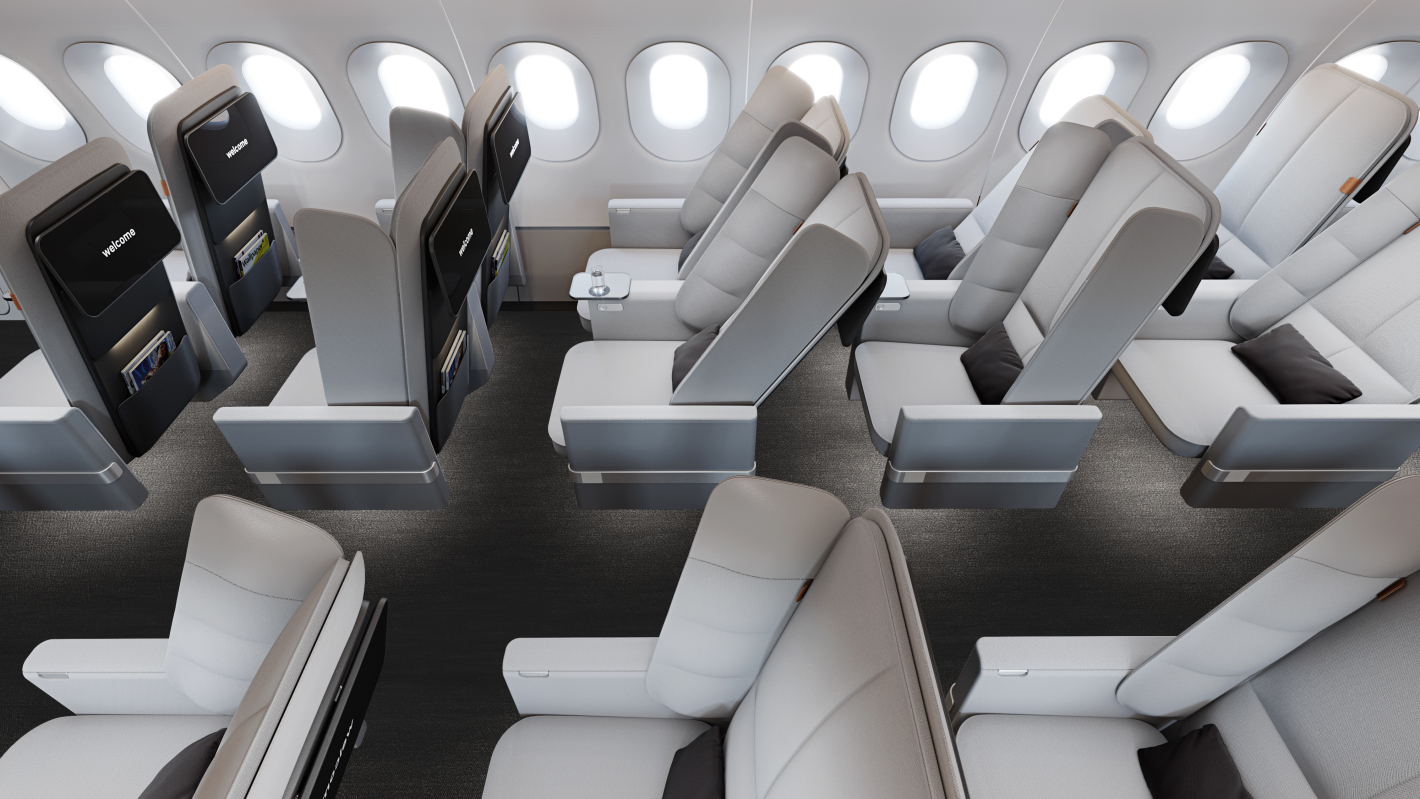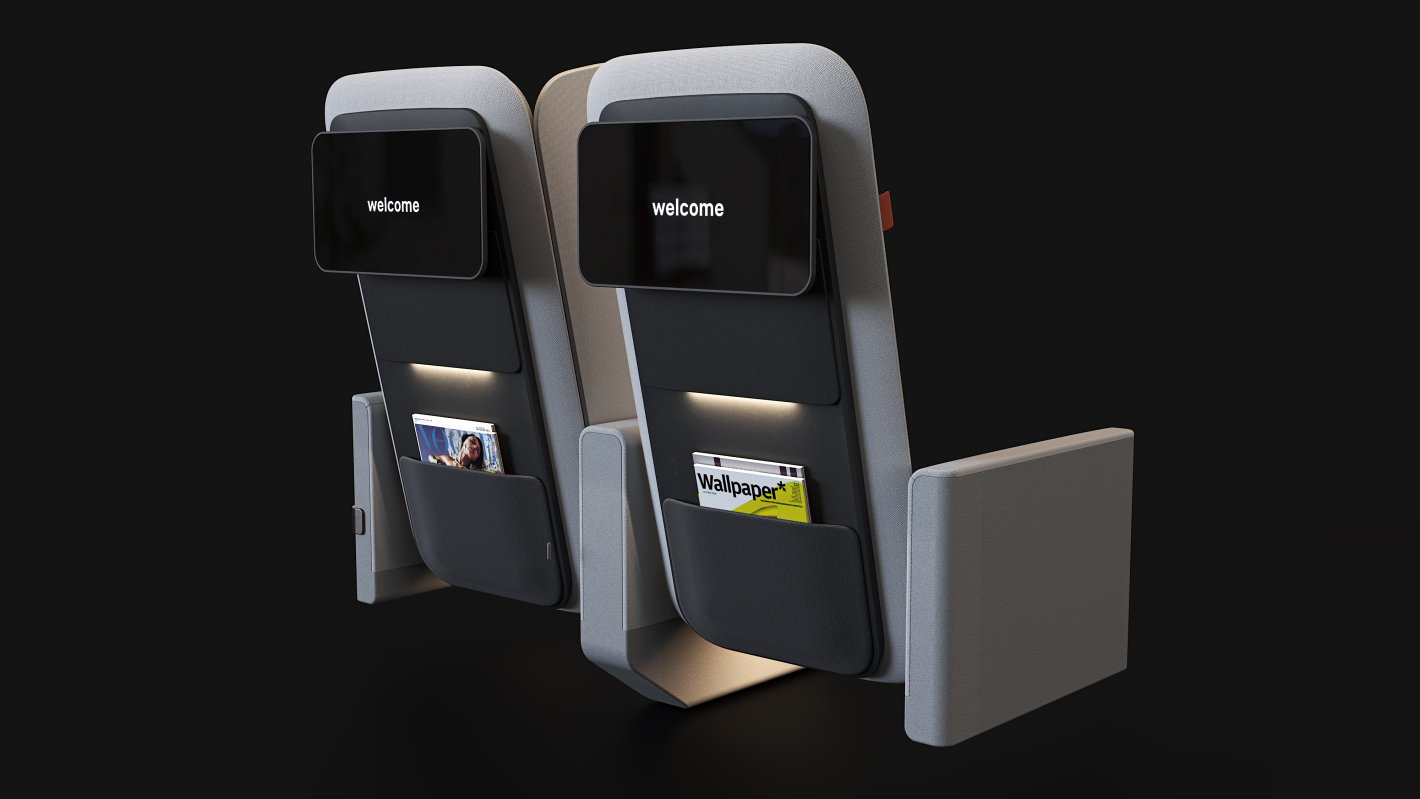Will a new premium economy class seat dubbed “Interspace” finally make flying behind the curtain more comfortable?
London-based design firm Universal Movement, a subsidiary of New Territory, has unveiled a new economy class seat design this week. The seat is called “Interspace” and provides greater lateral support than traditional economy class seats by allowing passengers to rotate and lean on a fold-out cushioned surface. These “wings” provide far greater support than a traditional headrest and can easily be extended or collapsed depending upon the phase of flight.
In describing the seat Universal Movement said:
“The product has been developed with the knowledge that aircraft cabins have traditionally failed to look beyond seat pitch (the space between a point on one seat and the same point on the seat in front of it) as the primary determinant of comfort.
What people crave is the ability to rotate and redistribute weight within their seat, which is why you often see people leaning on the window of the aircraft using makeshift pillows.”
Luke Miles, Founder and Chief Creative Officer at New Territory added:
“Universal Movement and Interspace have been borne from the fact that not enough time, thought and resources have been invested into the back of the aircraft cabin.
We believe that comfort, good posture and wellbeing is a human right irrespective of financial status or social class. If you consider the psychology of the cabin, its linear, grid-like form is restrictive and as a result, seats have been designed for what is essentially an unnatural posture and seating position. The time has come to seek designs, products and services which tackle this subject head-on, creating affordable solutions for those businesses who share the same values and desires.
For this reason, we wanted to break the mold with this first product, which is the first of many to come from Universal Movement.”
Here’s a video of the new seat in action:
Breaking #aircraft interiors news: Luke Miles, Co-Founder/Creative Director @NewTerritory_io unveils the Interspace aircraft seat & new interiors company in London. Premium Expnomy travellers, rejoice! #paxex#RedCabin2019#AvGeek#design#innovationpic.twitter.com/9G2i254IZ8
— APEX (@theAPEXassoc) December 5, 2019
Will Interspace Seat Work? Is It Practical?
Watch the video above…the seat doesn’t look much more comfortable than other current premium economy class seats, but certainly looks no worse. I’d have to give it a try, but I can imagine it would be improvement over no wings at all.
Not only could this be a next-generation premium economy seat, but we could also see it in domestic first class cabins in the United States and other markets that offer larger seats on narrowbody planes.





All image courtesy of Universal Movement
CONCLUSION
The seat was unveiled in London yesterday before many airline executives, though the new seat has no customers yet. It is nice to see seat designers tackle discomfort in an innovate way. Universal Movement promises more new designs in the months to come. I’ll be most interested in what they come up with for a true economy class seat.
What are your thoughts on the “Interspace” seat?


If my knees are jammed into the seat, it’s not going to matter whether I can tilt left or right a bit
I’m just curious but I’ve never been in premium economy and had my knees anywhere near cramped. Have you? In PE on Air New Zealand I was barely able to touch the seat in front of me if I reached forward to it.
It looks like reasonable knee space from the photos.
I think they’re on to something, not being able to twist or rotate at all is my main driver of discomfort (beyond obviously legroom but that’s only a problem in normal economy)
It’s certainly an interesting approach but I do wonder how useful it will be in practice. On daytime flights constrained space is my primary complaint especially if I want to use my laptop.
Now on flights when I want to sleep in coach my main issue is my head and leg position. Economy seats generally don’t have enough recline for my head to find a comfortable sleeping position and too often I end up with my head falling forward which isn’t good. The other issue is leg position and support. Those little footrest bars you see sometimes are useless. What’s required is a footrest that will elevate and support your feet and enough recline to be able to relax in comfort.
I’ve only flown AirFrance’s PE seat on the A380 and it didn’t offer enough of either recline or leg support to be truly comfortable if you wanted to sleep. I strongly suspect based on reviews all the other PE offerings have similar issues.
My hope (and prediction) is that what we will see is an evolution of PE towards something like the old UAL recliner business class seats. Those were not as nice as a lie flat bed to be sure but they were a very comfortable way to pass a long flight. Being able to get a seat like that at a reasonable upcharge over coach (and PE fares seem to have already moved beyond that) would be a game changer.
Happy to see someone at least pay lip service to seat comfort, we will need to see what the reality is.
The biggest problem I see is the self-reinforcing Stupidity Of Crowds. People demand a ticket that costs nothing, or as close to nothing as they can get. Airlines have gladly responded and have given the public exactly what they want: cheap flights. To drive the price down, they squeeze the seats closer and closer together. The result is the misery we see today.
If the seats get more comfortable, via some innovation, that’ll be great at first. Then the airlines will just squeeze them even closer together, so they can make tickets even cheaper. Until we have planes with seats that leave passengers literally wedged in, up against each other, in innovative, creative seats, but literally wedged on top of each other, just so tickets can cost a few bucks less. Lather, rinse, repeat.
I love it. They wouldn’t have to do away with the head rest though. It could rest above the foldable wing flaps and be made to slide up and down into position.
I don’t like it because there’s no padding.
It’d probably be nicer to apply them to existing seat designs. The underlying selling point also noting the thinness of the seat backs and trying to shift the narrative away from seat pitch and width is of course to make W more “efficient” by making it denser. Give people the privacy screens and the idea is they’d be more willing to tolerate the density, although some will feel the claustrophobia.
If there are more seats in a given space, then people will have less space to wiggle around, simple as that. In the meantime, I shall look to W products with more generous space such as CI and JL.
Also speaking of nightmare “fancy” W seats – Qantas and their much-maligned new premium economy seat.
I could be going out on a limb (NPI) here but the one thing I want from PE is… Private elbow space. Just give me an armrest I don’t have to share and I’ll be happy.